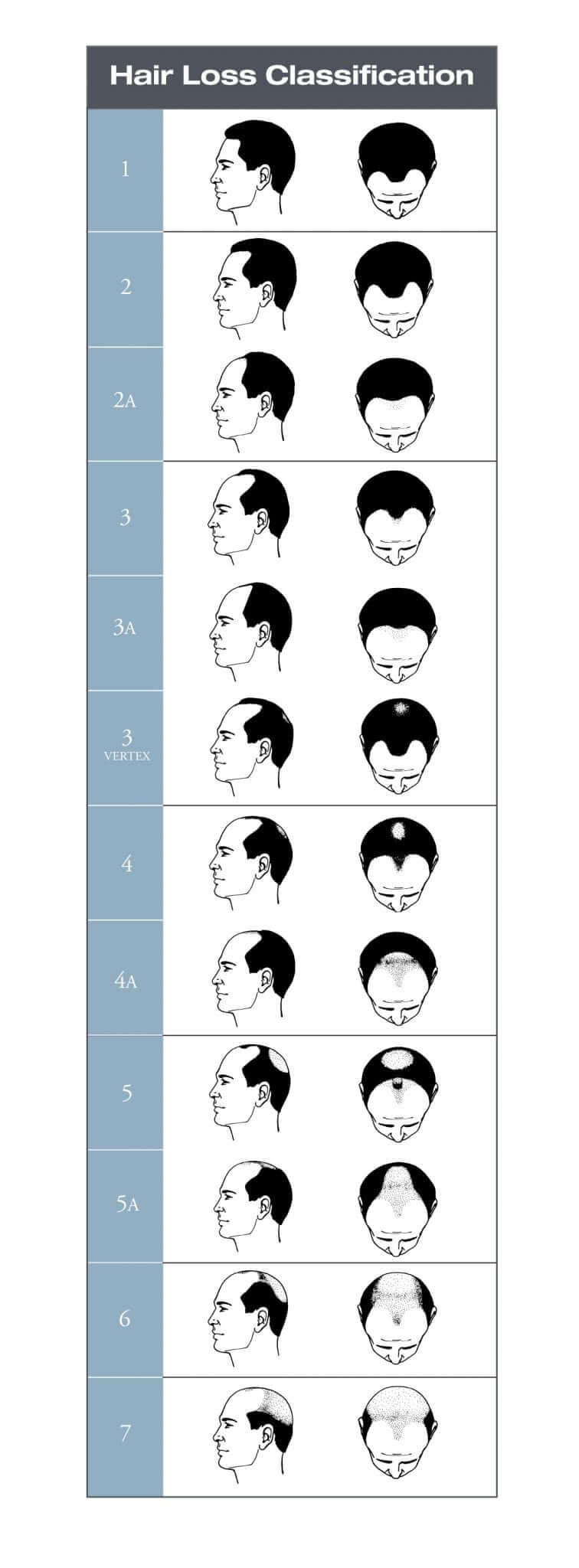Understanding Male Pattern Baldness
If you’re experiencing male pattern baldness (Androgenic Alopecia), you’re not alone. Pattern baldness is the most common form of hair loss for men, typically caused by some combination of genetics and hormonal factors.
Causes of Male Pattern Baldness
Each hair on your body sits in a hair follicle. Male pattern baldness usually begins when certain hair follicles start shrinking over time, making hair finer, shorter and weaker. Eventually, those brittle follicles stop producing new hair altogether, resulting in hair thinning and pattern baldness.
Symptoms of Male Pattern Baldness
Although male pattern baldness can usually be traced at the hairline, it can take many different forms on the head.
For instance, as your hairline gradually recedes with time, it may begin forming an “M” shape on your head starting at your widow’s peak. As additional follicles begin to weaken and more hair fall out, that “M” shape may eventually transform into an inverted “U” shape on both sides of your head, leaving little hair on top of your head and some on the sides.
Alternately, other men may experience balding only on top of their head, while still maintaining a healthy overall hairline. In any case of pattern baldness, the underlying causes are often the same.
How Do You Know If You Have Male Pattern Baldness?
For the most part, male pattern baldness can be determined by examining the appearance and pattern of hair loss using the Norwood Scale.
Male pattern baldness can also be identified by one of the following symptoms:
- Patches of hair loss
- Shedding of hair
- Hair breakage
- Hair loss with scaling, pain, or redness
In cases where the usual patterns do not exist or are not easily identifiable, undergoing a skin biopsy or other diagnostic procedure may be needed to understand the root cause of your hair loss, and to know if male pattern baldness is the culprit.

How Can Male Pattern Baldness Be Treated?
Luckily, today there are enough options for patients to choose from to help manage their hair loss, and avoid the emotional trauma, psychological stress, and loss of self-esteem that often comes with it. And, of course, if you are perfectly comfortable with the gradual changes in your appearance as your hair loss progresses, you can embrace your state of baldness!
There are a multitude of treatment options available today aimed at treating male pattern baldness, but it’s important to understand what these treatments promise and how they work.
There are two main types of hair loss solutions. One works by slowing down the progression of hair loss and the other helps regrow hair. Unfortunately there is no cure for hereditary hair loss. The only permanent way to get your hair restored remains to be surgical hair restoration (hair transplantation).
This does not mean that medications and solutions are not effective. They work best for people in early stages of hair loss and to complement hair transplantation. Here are some of the more common remedies for pattern baldness:
- Topical solutions: Topicals can be applied directly to your scalp to revitalize hair follicles that are shrunken due to male pattern hair loss and regrow hair. Depending on the condition and severity of hair loss, some people are able to regrow new hair, but continued use of the topical solution is necessary to maintain sustained results over time. The most common solution is Minoxodil, which is the main active ingredient in Rogaine®.
- Oral medications: Certain prescription pills can help curb the production of the male hormone (Dihydrotestosterone or DHT) responsible for pattern baldness. Much like the topical solutions, continued use is necessary to maintain any results yielded from the medication Today, Propecia is the most common drug used to treat male pattern baldness.
- Hair replacement: Many cosmetic solutions— like hair systems, wigs, toupees, and weaves— do not involve a surgical procedure. These solutions typically require some maintenance, and often come down to factors including one’s lifestyle, willingness to continue ongoing replacement maintenance and costs. The main benefit of cosmetic hair replacement is the full-head-of-hair results one can get immediately post application.
- Hair transplantation surgery: As performed by Bosley, this procedure involves taking hair follicles from one part of your head where there is healthy growing hair, and transferring them to the areas affected by baldness where hair is needed.
Typically, the area where the hair is transferred from can be found on the back of your head. That’s because the hair found in these areas of your scalp are known to be resistant to the hormone Dihydrotestosterone (or DHT) ─ the main culprit in male pattern baldness. The logic behind hair transplant surgery is that these DHT-resistant hairs, when transferred to balding or thinning areas, will continue to thrive and grow naturally as they would have in the donor area. And that’s why hair transplant surgery is often viewed as a permanent solution to hair loss.
Good hair transplantations are virtually undetectable. Bosley is known for permanent and natural-looking results, having perfected the art and science of hair restoration for more than 40 years.
To help determine which treatment option is best for your male pattern hair loss, you may want to take the first step by consulting with your physician or contacting Bosley to explore the various treatments options available to you, including permanent hair restoration. Schedule your free Bosley consultation now to learn which hair loss treatment options are best for you.
Learn More:
What to do next?
To learn more about your hair restoration options and the average hair transplant timeline, The Complete Book on Hair Restoration, to see how great your hair can look. If you’re ready to do something about that bald spot or thinning hair now, schedule a FREE in-person or video consultation with a trained Bosley hair restoration specialist. Together with a Bosley Physician, we can help you find out what’s causing your balding and what treatment solution is right for you.